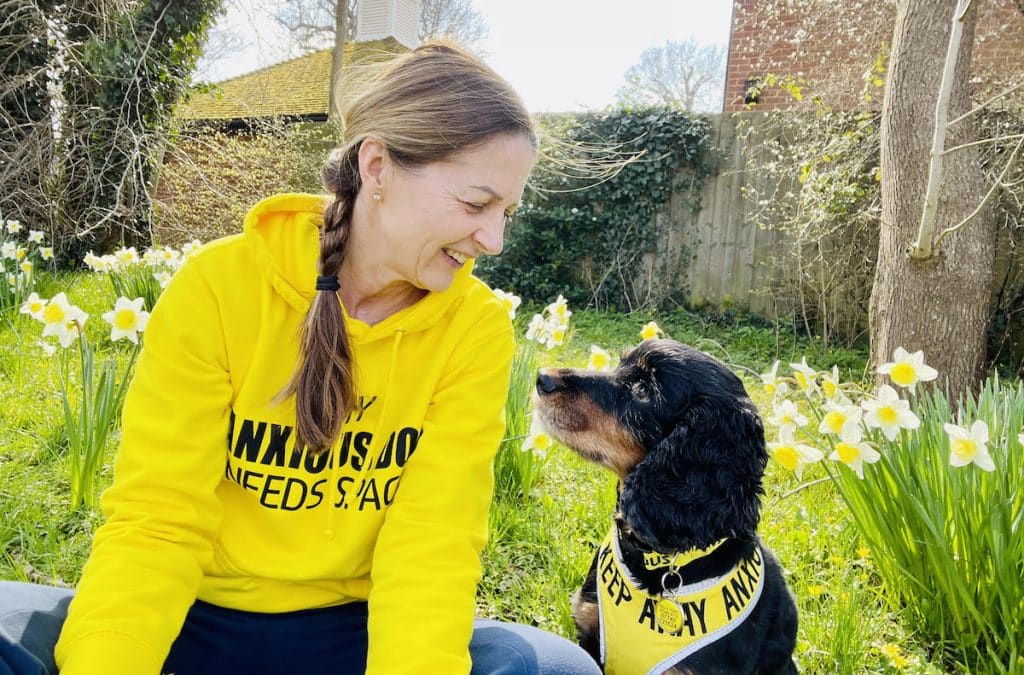The colour is used to show other pet parents that a dog is anxious, and #DogsInYellow day takes place on March 20th to raise awareness.
It was created by Sarah Jones who has her own anxious dog, Cocker Spaniel Bella.
Bella was only a pup when Sarah realised she was scared of dogs and people, but as you can imagine, being a cute dog, everyone wanted to fuss over her.
She learned wearing yellow could be a way to keep people away and created items for Bella like leads and harnesses.
And when others started asking for items for their dogs, her business My Anxious Dog was born.
Sarah started the awareness day in 2022 and shares the impact it’s had, plus we chat to Suzanne Elsworth, who tried out yellow on her dog Sparky.

Hi Sarah, tell us about how you’ve gone from wanting to advocate for your own dog to where you are now
When I first learned about yellow, it was about putting a yellow ribbon on your lead or collar, but on a pretty dog it was just made her look cuter.
I looked around for products around nine years ago and there wasn’t much out there.
So I decided to try and develop some products of my own. I made them for Bella and other owners asked if they could have them, and it’s kind of taken over my life!

Why did you create #DogsInYellow day? (March 20th)
I found yellow really helpful, but I’d suggest it to other owners and they’d say, ‘Oh, but nobody knows what it means.’
I went on mission to make sure people DID know what it means. And social media is a big thing nowadays.
So with the hashtag #DogsInYellow, it’s a perfect way to get the word out and help raise awareness for our dogs.
It’s so other people can understand. People often think if a dog barks or snaps, they’re an aggressive dog rather than just trying to communicate.
Most of the dogs that I’ve come across have had traumatic things happen in their life and deserve a little kindness.
Can you tell us about the impact the day has had?
Yes, so a huge 91 per cent of owners with shy or reactive or nervous dogs say they no longer feel that prisoners in their own home and are able to enjoy life.
Nearly a third are taking their dogs into pubs, restaurants and training classes and feeling more confident.
And 78% of anxious dog owners who use yellow report their dogs have more space, enjoy their walks, and feel more confident and calm.

Are there any other reasons a dog might benefit from wearing yellow?
Yes, if they’re an older dog, maybe they have arthritis or are slowing down and want to be left alone.
If they’ve had surgery or they’ve been injured and are recovering and their owner wants people to be careful around them.
They could be in season, they could be a service dog or a medical alert dog that shouldn’t be distracted.
Maybe they’re a rescue dog who has had a traumatic experience and they’re adapting to life in a new environment.
Yellow can give them the space to build their confidence.

Do you have a message for anyone who is considering yellow?
If you have an anxious or reactive dog or a dog and they need space, try the yellow. It comes from a place of love.
Rather than seeing it as something embarrassing or harsh, think of it as a voice for them, saying they want something to go away.
So embrace it and be proud of it. I’m very proud of my yellow. It’s given us both so much freedom and confidence to enjoy life.
How can other dog owners show their support?
If you see a dog in yellow and give them space, so by that I mean stop, put your dog on a lead, let them pass you, smile and be kind, it will make their day.
It’s that simple, and in my community I see how much this means to people, they are so happy when people are considerate to them.
And tell other owners what a dog in yellow means. Share the posts on #DogsInYellow on social media.
Even if your dog is absolutely fine, you’re making a difference.

What can people do on your #DogsInYellow day on March 20th?
If you have an anxious dog, share your story, your photos, be proud of your dog in yellow.
If you don’t please do come and join in. One of our messages is ‘What if everyone knew?’ and by sharing a post, you can help make that happen.
Want to find out more about Sarah and Dogs in Yellow?
Visit Sarah’s website: www.myanxiousdog.co.uk
Follow My Anxious Dog on Facebook: https://www.facebook.com/myanxiousdog
Connect on Instagram: https://www.instagram.com/myanxiousdog/
Join the Yellow Army Facebook Group: https://www.facebook.com/groups/215979409295118
Read the first part of our interview with Sarah: https://thepawpost.co.uk/meets/sarah-jones-my-anxious-dog/
Dogs in Yellow case study – Suzanne and Sparky

When your local park is a no-go zone thanks to gossiping dog owners more interested in their conversations than what their pups are up to, or you avoid certain routes at busy times of day, could using a bright yellow lead and a ‘keep dogs away’ tag make walks more pleasant?
Suzanne Elsworth and her terrier Sparky put it to the test.
“Sparky is a 13-year-old Patterdale/Lakeland Terrier cross.
“He’s typical of his breed – likes to chase anything that moves and can be unpredictable at times. He likes other dogs but wants to dominate and will nip if a dog comes running at him.
“That’s why we choose to walk him on routes that are quiet. We head to the woods or farmland footpaths rather than busy parks.
“If we go to our favourite beach, we turn left while most other walkers turn right, just so we can avoid as many dogs as possible.
“We want Sparky to have a great time off his lead, chasing his ball, without distractions.
“If we do have Sparky on the lead and another dog heads our way, then starts our dilemma. Will it just ignore him? Or do we need to start shouting ‘call your dog please!’ at the owner?
“If it’s the latter, the response varies.
“My most hated is when they say ‘it’s ok, my dog’s friendly’.
“Yep – but that’s not the point. My dog may not be. Other answers have ranged from ‘he doesn’t like being on a lead’ to ‘why?’
“It’s infuriating, it puts me on edge and I know that emotion can transfer to Sparky.

“We always have a pocket full of treats – a tempting gravy bone is generally enough to distract him from a passing pooch, though it doesn’t help when the dog starts leaping around him.
“Trying our yellow lead and ‘keep dogs away’ tag was intriguing.
“I did feel a little like tagging Sparky was giving him the doggy equivalent of an ASBO – despite the fact he’s largely a very good boy.
“But I do feel like it made a difference.
“Some people behaved differently when they spotted the very obvious request to give Sparky some space – though that was dependent on them actually paying attention, and also being close enough to read it.
“Those who did often physically moved their dogs out of the way with a smile or a cheery comment.

“But then there were the ones who paid no attention, because they were too busy talking, looking at their phones, or just paying little heed to those around them.
“How do you change their behaviour? I have no idea.
“Every dog could have an unpredictable moment and come to some harm.
“One of the most interesting encounters was with a gent with a huge beautiful Rottweiler. When he saw us coming he put her on her lead.
“We asked him if he’d done so because he saw our yellow lead but he said she hated small black dogs after being attacked so he was careful in case she retaliated again.
“He was interested in Sparky’s yellow lead but said, ‘no-one knows about those’.
“When I surveyed members of my favourite Patterdales’ Facebook group, 78 per cent said they knew what a yellow lead meant, while 15 per cent said they thought they did.
“That was really encouraging but it shows there is still more to be done.
“I for one will be spreading the word.”

Want to find out more about Sarah and Dogs in Yellow?
Visit Sarah’s website: www.myanxiousdog.co.uk
Follow My Anxious Dog on Facebook: https://www.facebook.com/myanxiousdog
Connect on Instagram: https://www.instagram.com/myanxiousdog/
Join the Yellow Army Facebook Group: https://www.facebook.com/groups/215979409295118





